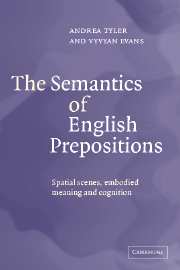Book contents
- Frontmatter
- Content
- Preface
- Acknowledgements
- 1 The nature of meaning
- 2 Embodied meaning and spatial experience
- 3 Towards a model of principled polysemy: spatial scenes and conceptualization
- 4 The semantic network for over
- 5 The vertical axis
- 6 Spatial particles of orientation
- 7 Bounded landmarks
- 8 Conclusion
- References
- Index
2 - Embodied meaning and spatial experience
Published online by Cambridge University Press: 22 September 2009
- Frontmatter
- Content
- Preface
- Acknowledgements
- 1 The nature of meaning
- 2 Embodied meaning and spatial experience
- 3 Towards a model of principled polysemy: spatial scenes and conceptualization
- 4 The semantic network for over
- 5 The vertical axis
- 6 Spatial particles of orientation
- 7 Bounded landmarks
- 8 Conclusion
- References
- Index
Summary
In the previous chapter we argued that our knowledge of the world is indirect because it is constrained by how we experience it. This follows as our experience of the world is always mediated via our uniquely human perceptual system, physiology and neural architecture. A hummingbird's understanding of gravity as a force which can be overcome for extended periods of time, albeit with effort, would be significantly different from a human's. Thus, a hummingbird no doubt experiences and represents the same world to itself in quite different ways from how human beings do; both versions of the world, while presumably very different, are equally ‘real’. As pointed out by the philosopher Hilary Putnam (1981), to claim that we can have direct access to and conscious knowledge of an objective reality (i.e., an objective god's-eye view of the world) is wrongheaded.
Nonetheless, we are not claiming that there is not a world ‘out there’ nor that our experience of it is unimportant. To say that our experience with and perceptions of the world are mediated by our conceptual system, and are fundamentally conceptual in nature, is not to say that the real world and its properties do not largely constitute the nature of our experience. On the contrary, it is the real world which provides the raw substrate for our sensory perceptions and the conceptualizations which arise from them. Accordingly, the spatio-physical properties of the world of humanly perceived experience are fundamental to human cognition.
- Type
- Chapter
- Information
- The Semantics of English PrepositionsSpatial Scenes, Embodied Meaning, and Cognition, pp. 23 - 36Publisher: Cambridge University PressPrint publication year: 2003



